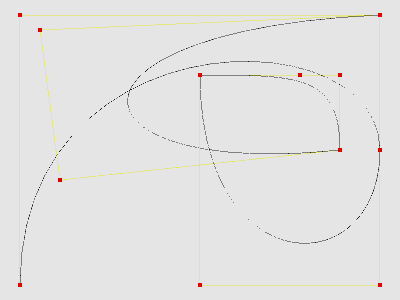oglplus/007_cubic_bezier.cpp
Shows how to render line approximating a cubic bezier curve

Copyright 2008-2014 Matus Chochlik. Distributed under the Boost Software License, Version 1.0. (See accompanying file LICENSE_1_0.txt or copy at http://www.boost.org/LICENSE_1_0.txt)
#include <oglplus/gl.hpp>
#include <oglplus/all.hpp>
#include <oglplus/bound/buffer.hpp>
#include "example.hpp"
#include <cmath>
namespace oglplus {
class RectangleExample : public Example
{
private:
// wrapper around the current OpenGL context
Context gl;
// Vertex shader
VertexShader vs;
// Fragment shader
FragmentShader fs;
// Program
Program prog;
// VAO and VBO for the curve approximation points
VertexArray curve;
Buffer curve_verts;
// The count of curve points
std::size_t curve_n;
// VAO and VBO for the curve control points
VertexArray control;
Buffer ctrl_verts;
// Handle for the Color uniform in fragment shader
Lazy<Uniform<Vec3f>> color;
// The count of control points
std::size_t ctrl_n;
public:
RectangleExample(void)
: color(prog, "Color")
{
// Set the vertex shader source and compile it
vs.Source(
"#version 330\n"
"in vec4 Position;"
"void main(void)"
"{"
" gl_Position = Position;"
"}"
);
// set the fragment shader source and compile it
fs.Source(
"#version 330\n"
"out vec4 fragColor;"
"uniform vec3 Color;"
"void main(void)"
"{"
" fragColor = vec4(Color, 1.0);"
"}"
);
// attach the shaders to the program
// link and use it
prog.AttachShader(vs).AttachShader(fs).Build().Use();
// the series of cubic bezier curves
Vec2f bezier_cps[] = {
Vec2f(-0.9f, -0.9f),
Vec2f(-0.9f, +0.9f),
Vec2f(+0.9f, +0.9f),
Vec2f(+0.9f, 0.0f),
Vec2f(+0.9f, -0.9f),
Vec2f( 0.0f, -0.9f),
Vec2f( 0.0f, +0.5f),
Vec2f(+0.5f, +0.5f),
Vec2f(+0.7f, +0.5f),
Vec2f(+0.7f, +0.0f),
Vec2f(-0.7f, -0.2f),
Vec2f(-0.8f, +0.8f),
Vec2f(+0.9f, +0.9f),
};
BezierCurves<Vec2f, double, 3> bezier(
std::vector<Vec2f>(
bezier_cps,
bezier_cps+sizeof(bezier_cps)/sizeof(bezier_cps[0])
)
);
gl.Bind(curve);
{
auto data = bezier.Approximate(25);
curve_n = data.size();
gl.Bound(Buffer::Target::Array, curve_verts).Data(data);
(prog|"Position").Setup<Vec2f>().Enable();
}
gl.Bind(control);
{
auto data = bezier.ControlPoints();
ctrl_n = data.size();
gl.Bound(Buffer::Target::Array, ctrl_verts).Data(data);
(prog|"Position").Setup<Vec2f>().Enable();
}
gl.ClearColor(0.9f, 0.9f, 0.9f, 0.0f);
}
void Reshape(GLuint width, GLuint height)
{
gl.Viewport(width, height);
}
{
gl.Clear().ColorBuffer();
// draw the lines between control points
color.Set(Vec3f(0.9f, 0.9f, 0.2f));
gl.Bind(control);
gl.DrawArrays(PrimitiveType::LineStrip, 0, ctrl_n);
// draw the curve
color.Set(Vec3f(0.1f, 0.1f, 0.1f));
gl.Bind(curve);
gl.DrawArrays(PrimitiveType::LineStrip, 0, curve_n);
// draw the control points
color.Set(Vec3f(0.9f, 0.0f, 0.0f));
gl.Bind(control);
gl.PointSize(8.0);
gl.DrawArrays(PrimitiveType::Points, 0, ctrl_n);
gl.PointSize(1.0);
}
};
void setupExample(ExampleParams& /*params*/){ }
std::unique_ptr<ExampleThread> makeExampleThread(
Example& /*example*/,
unsigned /*thread_id*/,
const ExampleParams& /*params*/
){ return std::unique_ptr<ExampleThread>(); }
std::unique_ptr<Example> makeExample(const ExampleParams& /*params*/)
{
return std::unique_ptr<Example>(new RectangleExample);
}
} // namespace oglplus
Copyright © 2010-2014 Matúš Chochlík, University of Žilina, Žilina, Slovakia.
<matus.chochlik -at- fri.uniza.sk>
<chochlik -at -gmail.com>
Documentation generated on Mon Sep 22 2014 by Doxygen (version 1.8.6).
<matus.chochlik -at- fri.uniza.sk>
<chochlik -at -gmail.com>
Documentation generated on Mon Sep 22 2014 by Doxygen (version 1.8.6).
